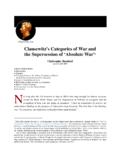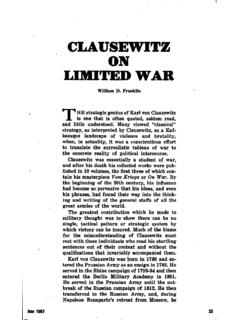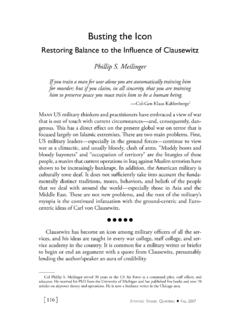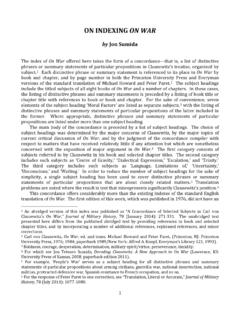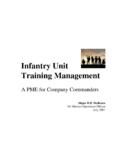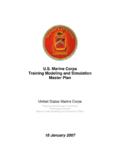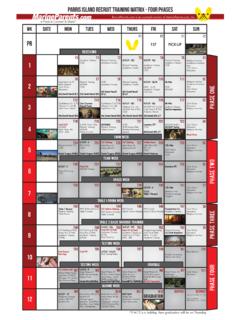Transcription of DEPARTMENT OF THE NAVY - Carl von Clausewitz
1 DEPARTMENT OF THE NAVY. Headquarters united states Marine corps Washington, 20380-1775. 20 June 1997. FOREWORD. Since Fleet Marine Force Manual 1, warfighting , was first published in 1989, it has had a significant impact both inside and outside the Marine corps . That manual has changed the way marines think about warfare. It has caused energetic debate and has been translated into several foreign languages, issued by foreign militaries, and published commercially. It has strongly influenced the development of doctrine by our sister Services. Our current naval doctrine is based on the tenets of maneuver warfare as described in that publication. Current and emerging concepts such as operational maneuver from the sea derive their doctrinal foundation from the philosophy contained in warfighting .
2 Our philosophy of warfighting , as described in the manual, is in consonance with joint doctrine, contributing to our ability to operate harmoniously with the other Services. That said, I believe warfighting can and should be improved. Military doctrine cannot be allowed to stagnate, especially an adaptive doctrine like maneuver warfare. Doctrine must continue to evolve based on growing experience, advancements in theory, and the changing face of war itself. It is in this spirit that warfighting has been revised, and this publication, Marine corps Doctrinal Publication 1, supersedes Fleet Marine Force Manual 1. I have several goals for this revision. One goal is to enhance the description of the nature of war for example, to emphasize war's complexity and unpredictability and to widen the definition of war to account for modern conflict's expanding forms.
3 Another goal is to clarify the descriptions of styles of warfare. A third goal is to clarify and refine important maneuver warfare concepts such as commander's intent, main effort, and critical vulnerability. It is my intent to do this while retaining the spirit, style, and essential message of the original. Very simply, this publication describes the philosophy which distinguishes the Marine corps . The thoughts contained here are not merely guidance for action in combat but a way of thinking. This publication provides the authoritative basis for how we fight and how we prepare to fight. This book contains no specific techniques or procedures for conduct. Rather, it provides broad guidance in the form of concepts and values.
4 It requires judgment in application. warfighting is not meant as a reference manual; it is designed to be read from cover to cover. Its four chapters have a natural progression. Chapter 1 describes our understanding of the characteristics, problems, and demands of war. Chapter 2. derives a theory about war from that understanding. This theory in turn provides the foundation for how we prepare for war and how we wage war, chapters 3 and 4, respectively. Experience has shown that the warfighting philosophy described on these pages applies far beyond the officer corps . I. expect all marines enlisted and commissioned to read this book, understand it, and act upon it. As General A. M. Gray stated in his foreword to the original in 1989, this publication describes a philosophy for action that, in war, in crisis, and in peace, dictates our approach to duty.
5 C. C. KRULAK. General, Marine corps Commandant of the Marine corps DISTRIBUTION: 142 000006 00. 1997 united states Government as represented by the Secretary of the Navy. All rights reserved. Throughout this publication, masculine nouns and pronouns are used for the sake of simplicity. Except where otherwise noted, these nouns and pronouns apply to either gender. PREFACE. Eight years ago the Marine corps published the first edition of warfighting . Our intent was to describe my philosophy on warfighting , establish it as Marine corps doctrine, and present it in an easy-to-read format. In the foreword to that manual, I charged every officer to read and reread the text, to understand it, and to take its message to heart.
6 We have succeeded. warfighting has stimulated discussion and debate from classrooms to wardrooms, training areas to combat zones. The philosophy contained in this publication has influenced our approach to every task we have undertaken. Fleet Marine Force Manual 1 stated, War is both timeless and ever changing. While the basic nature of war is constant, the means and methods we use evolve continuously. Like war itself, our approach to warfighting must evolve. If we cease to refine, expand, and improve our profession, we risk becoming outdated, stagnant, and defeated. Marine corps Doctrinal Publication 1 refines and expands our philosophy on warfighting , taking into account new thinking about the nature of war and the understanding gained through participation in extensive operations over the past decade.
7 Read it, study it, take it to heart. Semper Fidelis, A. M. GRAY. General, Marine corps (Ret.). 29th Commandant of the Marine corps warfighting Chapter Nature of War War Defined Friction Uncertainty Fluidity . Disorder Complexity The Human Dimension . Violence and Danger Physical, Moral, and Mental Forces The Evolution of War The Science, Art, and Dynamic of War Conclusion Chapter Theory of War War As an Act of Policy Means in War The Spectrum of Conflict Levels of War Initiative and Response Styles of Warfare Combat Power . Speed and Focus Surprise and Boldness Centers of Gravity and Critical Vulnerabilities Creating and Exploiting Opportunity Conclusion Chapter for War Force Planning Organization Doctrine . Professionalism Training Professional Military Education Personnel Management Equipping.
8 Conclusion warfighting MCDP 1. Chapter Conduct of War The Challenge Maneuver Warfare Orienting on the Enemy Philosophy of Command Shaping the Action . Decisionmaking Mission Tactics Commander's Intent . Main Effort Surfaces and Gaps Combined Arms . Conclusion Chapter 1. The Nature of War Everything in war is simple, but the simplest thing is diffi- cult. The difficulties accumulate and end by producing a kind of friction that is inconceivable unless one has experienced war. 1. Carl von Clausewitz In war the chief incalculable is the human will. 2. B. H. Liddell Hart Positions are seldom lost because they have been destroyed, but almost invariably because the leader has decided in his own mind that the position cannot be held.
9 3. A. A. Vandegrift MCDP 1 The Nature of War T o understand the Marine corps ' philosophy of warfight- ing, we first need an appreciation for the nature of war itself its moral, mental, and physical characteristics and de- mands. A common view of war among marines is a necessary base for the development of a cohesive doctrine because our approach to the conduct of war derives from our understanding of the nature of war. WAR DEFINED. War is a violent clash of interests between or among orga- nized groups characterized by the use of military force. These groups have traditionally been established nation- states , but they may also include any nonstate group such as an interna- tional coalition or a faction within or outside of an existing state with its own political interests and the ability to gener- ate organized violence on a scale sufficient to have significant political consequences.
10 The essence of war is a violent struggle between two hostile, independent, and irreconcilable wills, each trying to impose it- self on the other. War is fundamentally an interactive social process. Clausewitz called it a Zweikampf (literally a two- struggle ) and suggested the image of a pair of wrestlers locked in a hold, each exerting force and counterforce to try to throw the War is thus a process of continuous mutual 3. warfighting MCDP 1. adaptation, of give and take, move and countermove. It is criti- cal to keep in mind that the enemy is not an inanimate object to be acted upon but an independent and animate force with its own objectives and plans. While we try to impose our will on the enemy, he resists us and seeks to impose his own will on us.

